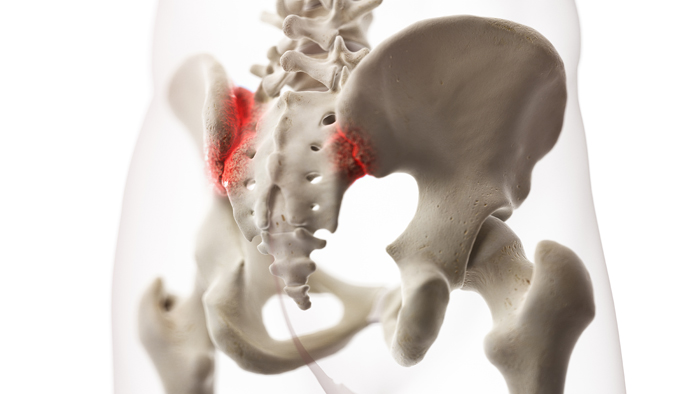Sacroiliac Joint Pain Treatment & Diagnostics in Chembur, Mumbai
Sacroiliac Joint Pain
Introduction
Pain in your lower back and buttocks is called Sacroiliac (SI) joint pain. Sacroiliac joint pain may occur due to injury or damage to the SI joint. Sacroiliac joint pain may mimic other disease conditions. Hence, an accurate diagnosis is required. Physical therapy, medications, and non-surgical therapy are usually the first line of treatment. In some cases, surgical treatment may also be required. Sacroiliac joint pain is the cause of 15% to 30% of chronic lower back pain complaints.

What is Sacroiliac Joint Pain?
The sacrum is the bone at the bottom of your spine, while the ilium is one of your hip bones situated at the upper part of your pelvis. Your SI joint is the meeting point of the sacrum and ilium. Sacroiliac joint pain occurs when there is a misalignment of the SI joint bones, which leads to dull or sharp pain beginning at your SI joint. It may then radiate to your upper back, buttocks, thighs, and groin.
What are the Symptoms of Sacroiliac Joint Pain?
The common symptoms of sacroiliac joint pain include:
- Pain in the lower back may radiate to the hips, pelvis, buttocks, thighs, and groins.
- Unilateral or bilateral SI joint pain.
- Numbness, tingling, or weakness in the leg.
- Pain or difficulty when sitting, sleeping, standing, walking, or climbing steps.
- Worsening of pain when you perform transitional movements (from sitting to standing).
What Causes Sacroiliac Joint Pain?
- The loosening or tightening of ligaments due to work injuries, falls, accidents, pregnancy, childbirth, or hip or spinal surgery may cause this pain.
- Uneven movement on both sides of your pelvis due to one leg being weaker, arthritis, or knee issues.
- Certain autoimmune diseases (in which your own body attacks healthy cells).
- Biomechanical factors like non-supportive footwear or wearing boots after ankle or foot surgery.
When Should You Consult a doctor?
If your lower back, buttock, or thigh pain continues despite remedial measures, do not hesitate to contact your doctor for a detailed assessment. You can search for a Sacroiliac Joint Pain specialist near me or Sacroiliac Joint Pain hospitals near me or simply
You can request an appointment at Apollo Spectra Hospitals, Chembur, Mumbai.
Call1860 500 2244 to book an appointment.
How is Sacroiliac Joint Pain Diagnosed?
Your doctor may perform a physical examination by asking you to move or stretch in particular ways to localize your source of pain. He may also advise certain imaging tests such as X-rays, MRIs, and CT scans. In some cases, a numbing drug may be injected into your SI joint. If your pain disappears after a short span post the injection, the cause of your pain is most likely your SI joint.
How is Sacroiliac Joint Pain Treated?
Sacroiliac joint pain is treated with physical therapy, low-impact exercises, massages, wearing a sacroiliac belt, using cold packs, or heat application, depending on the intensity of the pain. If these therapies do not facilitate pain management, your doctor may recommend medication or non-surgical therapies. These include muscle relaxants, anti-inflammatory medications, steroids, or radiofrequency ablation procedures in which pain-causing nerves are deactivated. Surgery is the last recourse if other treatments have failed. Your doctor may advise a sacroiliac joint fusion surgery to reduce chronic pain. If you have any doubts, you can search for a Sacroiliac Joint Pain doctor near me or Sacroiliac Joint Pain hospitals near me or simply
Request an appointment at Apollo Spectra Hospitals, Chembur, Mumbai
Call1860 500 1066 to book an appointment.
Conclusion
Sacroiliac joint pain can be problematic if it is chronic. However, the good news is that with appropriate treatment, your pain can be relieved significantly. You can adopt certain preventive measures, such as exercising and following a healthy lifestyle, to prevent the pain from increasing.
Pregnancy, gait abnormalities, excessive strenuous exercises, a discrepancy in the length of your legs, SI joint dysfunction due to other contributing problems like osteoarthritis or gout are some risk factors.
If untreated, sacroiliac joint pain can lead to loss of mobility, disrupted sleep, and depression. If arthritis is a coexisting condition, fusion and stiffening of your vertebrae (bones) may occur.
Measures like maintaining a good posture while sitting, standing, sleeping, or walking, following proper lifting techniques, following work area ergonomics, maintaining a healthy weight, ensuring good nutrition, managing stress, and avoiding smoking can prevent sacroiliac joint pain.
Our Top Specialities
NOTICE BOARD
CONTACT US
CONTACT US
 Book Appointment
Book Appointment


.svg)
.svg)
.svg)
.svg)








